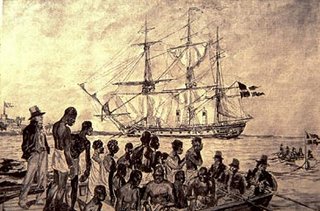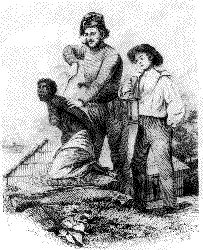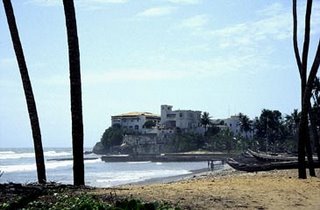demark & slavery
lock, stock & barrel

FREDENSBORG SLAVE SHIP being loaded
The slaves, who made up the live cargo, were burdened by grief and desperation. Many had probably been sold several times before ending up in the fort's dungeons or barracoons, but their introduction to a large slave ship was even more terrifying than the journey to the coast and the fort.
At midnight, 23 April 1768, The Fredensborg set sail with a cargo of 265 enslaved Africans, 928 kilograms of ivory and 1.25 kilograms of gold. In order to prevent revolt the slaves were chained together two by two, using foot shackles.

THE HUMAN CARGO
158 MALE SLAVES
78 FEMALE SLAVES
9 GIRL SLAVES
20 BOY SLAVES
TOTAL
265 ENSLAVED AFRICANS

Fort Fredensborg, meaning Castle of Peace, was constructed during the years 1736-42. The fortress was located at Ningo for strategic reasons: to attract trade on the eastern coast, to prevent competition from the Dutch and English forts in Accra, and to enable trade exchanges with Portuguese and French ships in particular. Though fairly small, Fort Fredensborg played a key role in Danish-Norwegian trade during the eighteenth century. The fort was described by contemporary observers as one of the most beautiful buildings on the coast.
The Danish colonies on the West Indies were established and managed by a private enterprise called The Danish West India & Guinea Company, with headquarters in Copenhagen and trading centres in the Caribbean and in Guinea.At first, The Danish West India Company recruited Danish labour as workforce for their sugar plantations in the Vestindien. However, as many other European planters had already discovered by that time, white immigrants were not able to stand hard labour conditions in the Tropics. There was a very high mortality rate among the white workers arrived in the plantations and soon the Danish West India Company would find a solution for their workforce shortage: slavery.
Denmark historians claim that their decision to abolish slavery was a moral one. Nevertheless this hypocritical legislation permitted a grace period of more than a decade to continue trading in the human cargo.
When this fort was about to be attacked by the indigenous peoples and was eventually put down by a Danish warship bombarded their positions rom the sea.

may the ancestors be pleased with the efforts of those who resisted Chattel Slavery


0 Comments:
Post a Comment
<< Home